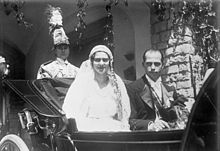You can help expand this article with text translated from the corresponding article in German. (November 2012) Click [show] for important translation instructions.
|
| Archduke Anton | |||||
|---|---|---|---|---|---|
 The Archduke on his wedding day | |||||
| Carlist-Carloctavismo claimant to the Spanish throne as Antonio I | |||||
| Pretense | 24 December 1953 – 1961 | ||||
| Predecessor | Carlos VIII | ||||
| Successor | Francisco I | ||||
| Born | 20 March 1901 Vienna, Empire of Austria | ||||
| Died | 22 October 1987 (aged 86) Salzburg, State of Salzburg, Republic of Austria | ||||
| Burial | Cemetery on the Mondsee | ||||
| Spouse | |||||
| Issue | 6, including Dominic | ||||
| |||||
| House | Habsburg-Lorraine | ||||
| Father | Archduke Leopold Salvator of Austria, Prince of Tuscany | ||||
| Mother | Infanta Blanca of Spain | ||||
| Religion | Roman Catholic | ||||
Archduke Anton of Austria, Prince of Tuscany (Anton Maria Franz Leopold Blanka Karl Joseph Ignaz Raphael Michael Margareta Nicetas von Habsburg-Lothringen; Vienna, 20 March 1901 – Salzburg, 22 October 1987) was a possible Carlist-Carloctavismo pretender to the Spanish throne[1] and an Archduke of Austria by birth.
- ^ Mercedes Vázquez de Prada. L (2016) El final de una ilusión: Auge y declive del tradicionalismo carlista (1957-1967).